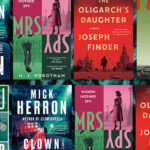
Some Practical Notes for Publishers on Readers with ALS
David Stam Has Some Firsthand Ideas About Accessibility in Publishing
I’m an avid reader with ALS—a bad combination. My reading was turned upside-down in 2008 by a diagnosis of amyotrophic lateral sclerosis, often known as Lou Gehrig’s disease. Without cure, its symptoms vary among patients, often including loss of finger dexterity. My symptoms began primarily as unexplained falls and growing inability to button shirts and coats. Only later did my wife, Deirdre, and I appreciate Lear’s deathbed plea: “Pray Sir, undo the button.” It’s now one of our favorite Shakespearian lines.
Much has happened since then. I’ve been writing all my life, but for half of my 86-year life, formal writing took a back seat to my 40-year library career, which included higher degrees in English (Wheaton College, Illinois); Library Science from Rutgers University; and a Ph.D. in History from Northwestern University. Along this journey I was fortunate to be appointed to increasingly responsible posts at The New York Public Library (clerk-typist to Assistant Editor of Library Publications); Librarian of Marlboro College (Vermont); Associate Librarian of the Newberry Library (Chicago); Milton S. Eisenhower Librarian, Johns Hopkins (Baltimore); a return to New York Public Library as the Andrew W. Mellon Director of the Research Libraries of NYPL (1978-86), and finally before retirement, University Librarian of Syracuse University from 1986-98.
Significant before that time was two years’ service in the US Navy as a journalist, including many voyages in and about the Atlantic, a compelling visit to Antarctica, and a final assignment as librarian of the USS Galveston ashore in Philadelphia. The result was a lifetime obsession with the history of polar exploration, often in remission but seldom far from the surface. Retirement in 1998 brought liberation to read and write about what most mattered to me. With Deirdre’s collaboration, our work on reading in polar settings, Adventures in Polar Reading, was published by the Grolier Club in 2019, following our 2005 exhibition and catalog, Books on Ice. With many polar centennials occurring early this century, interest in the “Heroic Age” of Amundsen, Scott, Shackleton, and others mushroomed among the public and specialists in all aspects of polar history.
My passion for reading such books remains, but reading them has become increasingly difficult. ALS is an auto-immune disease which interrupts the nerve commands that flow through the spinal cord to the appropriate muscles. My case has primarily involved the upper body—the pervasive atrophy of the arm muscles and the loss of strength in muscle activity, especially in the fingers and arms. I can’t lift heavy books and I have difficulty turning pages, lifting my arms to turn off reading lamps, and shifting to more comfortable positions.
Readers like me will keep reading as long as we can; we will never stop trying to find a way.
Almost everything with ALS takes more time, often twice as much as before: bathing, drying, dressing, eating, walking, exercising, writing, typing, sleeping itself, even reading. The assault on our reading ability is insidious: it distracts our attention, harms our concentration, destroys the rhythm of the prose and poetry, and the frequent involuntary nap requires re-reading to find the place to resume after falling asleep. There are a number of other factors that affect my reading of words in physical form. It’s a personal list, though I suspect several factors are widely shared.
Weight: In this era of mega-tomes, weight is an obvious problem. I need help positioning some books, usually with a homecare aide resting the book on a pillow. My four devices for holding books open don’t work with heavy books. Contributing to the problem is glossy calendared paper, often used for lustrous illustrated books. Reflections on the page require constant adjustment of the head, the page, and often the book itself, depending on weight, binding, and openability. None of this makes any kind of note taking easy or possible. I am currently being introduced to the technology of eye control to compose both written and spoken speech. After two training sessions I confess to feeling overwhelmed but hopeful of speeding up a slow process.
Openability: I divide books into three categories: one-, two-, and three-fisted. The first can lie flat, or open on a reading device, with easy page turning. The pages remain open while taking notes by hand (if possible) or a computer, on which I can still type. The second requires two hands to hold the work open, and turning pages is harder. The third, and most typical book format, is impossible for people with my kind of physical disability: a tightly bound perfect binding. “Perfect” is a euphemism for books whose sections (signatures) are evenly cut at the inner margins by guillotine. Then the pages are reattached by adhesives at the reduced inner margins, creating a strong but unreadable volume.
Notes: Endnotes in two- and three-fisted books go unread. Footnotes are preferable and needn’t always follow the convention of smaller font.
Margins: For disabled readers who retain handwriting ability, wider inner margins are a boon.
Type size: For people with visual disabilities and older readers, type size affects readability. Presses increasingly want more words per page, using smaller typefaces with tight line spacing.
Technology: In this case, the eBook is no salvation. Having spent much of my life reading in bed, I now find my arms too weak to hold a Kindle for more than a few seconds. More important is that digitized works don’t facilitate citations for retrieval purposes, lacking pagination amidst their changeable fonts and type sizes. The exception is the immense data bases of the HathiTrust and similar collections with page images and digitized equivalents of millions of books, easily read and copied on the desktop. They have enabled me to continue work long after my personal “Use By date.”
Also of note are factors that affect the reading of newspapers, journals, and magazines. The tabloid format is easier to manipulate than larger alternatives. Ordinary six-column newspapers are two-fisted, which is doable for me, but adding single sheets in the middle raises them to three fists, which is unmanageable. Online versions are available, but old reading habits die hard. Literary journals such as the New York Review of Books, the London Review of Books, and TLS are readable, have stapled inner margins, and fold easily.
Readers like me will keep reading as long as we can; we will never stop trying to find a way. These physical needs, plus old age, don’t terminate a lifetime addiction to reading. Mechanical aids keep advancing our ability to read, write, and communicate, even as those abilities gradually disappear. My own hero is historian Tony Judt, who wrote several significant books in his last few years. He must have had considerable help, a text reader, and amanuensis, at the least.
Despite all, I have been lucky in my encounter with ALS, living far longer than most fellow victims, with excellent care from the Veterans Administration. But I wish publishers would accommodate some of the desiderata explained here: lighter books, larger type, wider margins, and openable structures.
David Stam
David H. Stam claims he has been writing throughout his life: grade school essayist; contributor to high school magazine; editor of college weekly. Academic writing through three degrees: BA (English); MLS (Library Science); Ph. D. History, culminating with his dissertation (England’s Calvin. The Reception of Jean Calvin in Tudor England); other graduate studies in divinity and English. Journalist US Navy. Assistant Editor of Library Publications, NYPL, followed by 35 years of library administration with dozens of contributions to professional library journals and other publications. His retirement in 1998 provided opportunity for works of larger scope, including An International Dictionary of Library Histories, edited by David H. Stam; Books on Ice: British & American Literature of Polar Exploration, Curated by David H. Stam and Deirdre C. Stam; What Happened to Me, a Memoir, by David H. Stam; and Adventures in Polar Reading: The Book Cultures of High Latitudes, by David H. Stam with Deirdre C. Stam.



















